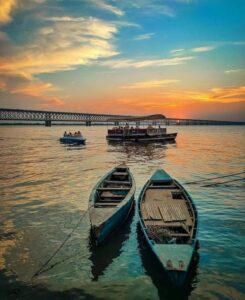Peninsular Rivers
(Relevant for Geography Section of General Studies Paper Prelims/Mains)

Peninsular Rivers
Peninsula Rivers display a greater antiquity compared to Himalayan Rivers {Dissimilar Origins}. The drainage pattern within the peninsula is primarily Harmonious, with the exception of a few rivers in the Upper Peninsula region. These rivers are non-perennial in nature, experiencing their highest flow during the rainy season. Peninsular rivers have reached a state of maturity {Fluvial Landforms}, nearly approaching their base level. (Vertical erosion is minimal). Characterized by wide and shallow valleys, the riverbanks typically exhibit gradual slopes, though some localized areas show steep sides due to faulting.
The key water divide in the peninsular region is established by the Western Ghats, which extend from north to south along the western coastline. Owing to the gentle gradient, the water velocity within these rivers is low, and they possess a limited capacity to transport sediment. Many significant peninsular rivers, such as the Mahanadi, Godavari, Krishna, and Cauvery, flow eastward and ultimately empty into the Bay of Bengal, forming deltas at their estuaries. In contrast, westward-flowing rivers like the Narmada and Tapi, as well as those originating from the Western Ghats and emptying into the Arabian Sea, create estuaries instead of deltas.
Certain areas witness the formation of superimposed and rejuvenated drainage systems, exemplified by landmarks such as: Instances include the Sharvati’s Jog Falls (289 m), Mahabaleshwar’s Yenna Falls (183 m), Cauvery’s Sivasamundram Falls (101 m), Gokak Falls (55 m), as well as Kapildhara (23 m) and Dhuandar (15 m) on the Narmada. These waterfalls stand out as major geographical features in Peninsular India.
Origin of peninsular river system
- Geologists theorize that the Sahyadri-Aravali axis served as the primary water division in the past. One hypothesis suggests that the present-day peninsula constitutes the remaining portion of a larger landmass. Within this expanse, the Western Ghats occupied a central position. Consequently, drainage occurred in two directions: one flowing eastward into the Bay of Bengal and the other westward, emptying into the Arabian Sea.
Subsequently, the western segment of the Peninsula underwent fracturing and submersion into the Arabian Sea during the early Tertiary period, which coincided with the Himalayan formation. As a result of the Indian plate’s collision, certain regions of the Peninsular block experienced subsidence, leading to the development of a series of rifts characterized by troughs and faults. Through these rifts, the Narmada and Tapi rivers, currently flowing westward on the Peninsula, find their course.
- This theory holds promise due to factors such as the Peninsula’s linear coastline, the steep western incline of the Western Ghats, and the absence of delta formations along the western coast.
Direction of flow
Despite the prevalent west-to-east trajectory of Peninsular Rivers, a meticulous examination discloses three primary patterns of flow.
Rivers such as Cauvery, Krishna, Godavari, Mahanadi, and numerous smaller watercourses discharge their waters south eastward into the Bay of Bengal. Conversely, Narmada, Tapi, and various minor streams originating from the Western Ghats meander westward, reaching the Arabian Sea. Furthermore, rivers like Chambal, Betwa, Ken, Son, and Damodar (tributaries of Ganga and Yamuna) adopt a north-easterly course.
To master these intricacies and fare well in the Sociology Optional Syllabus, aspiring sociologists might benefit from guidance by the Best Sociology Optional Teacher and participation in the Best Sociology Optional Coaching. These avenues provide comprehensive assistance, ensuring a solid understanding of sociology’s diverse methodologies and techniques.
Peninsular Rivers, India, Geography, Mahanadi, Godavari, Krishna, Cauvery, Narmada, Tapi, Fluvial Landforms, Western Ghats, Bay of Bengal, Arabian Sea, Waterfalls, Drainage Systems, Water Divide, Geology, Sahyadri-Aravali axis, Himalayan formation, Peninsular Rivers, India, Geography, Mahanadi, Godavari, Krishna, Cauvery, Narmada, Tapi, Fluvial Landforms, Western Ghats, Bay of Bengal, Arabian Sea, Waterfalls, Drainage Systems, Water Divide, Geology, Sahyadri-Aravali axis, Himalayan formation, Peninsular Rivers, India, Geography, Peninsular Rivers, India, Geography, Best Sociology Optional Coaching, Sociology Optional Syllabus.
Choose The Best Sociology Optional Teacher for IAS Preparation?
At the beginning of the journey for Civil Services Examination preparation, many students face a pivotal decision – selecting their optional subject. Questions such as “which optional subject is the best?” and “which optional subject is the most scoring?” frequently come to mind. Choosing the right optional subject, like choosing the best sociology optional teacher, is a subjective yet vital step that requires a thoughtful decision based on facts. A misstep in this crucial decision can indeed prove disastrous.
Ever since the exam pattern was revamped in 2013, the UPSC has eliminated the need for a second optional subject. Now, candidates have to choose only one optional subject for the UPSC Mains, which has two papers of 250 marks each. One of the compelling choices for many has been the sociology optional. However, it’s strongly advised to decide on your optional subject for mains well ahead of time to get sufficient time to complete the syllabus. After all, most students score similarly in General Studies Papers; it’s the score in the optional subject & essay that contributes significantly to the final selection.
“A sound strategy does not rely solely on the popular
Opinion of toppers or famous YouTubers cum teachers.”
It requires understanding one’s ability, interest, and the relevance of the subject, not just for the exam but also for life in general. Hence, when selecting the best sociology teacher, one must consider the usefulness of sociology optional coaching in General Studies, Essay, and Personality Test.
The choice of the optional subject should be based on objective criteria, such as the nature, scope, and size of the syllabus, uniformity and stability in the question pattern, relevance of the syllabic content in daily life in society, and the availability of study material and guidance. For example, choosing the best sociology optional coaching can ensure access to top-quality study materials and experienced teachers. Always remember, the approach of the UPSC optional subject differs from your academic studies of subjects. Therefore, before settling for sociology optional, you need to analyze the syllabus, previous years’ pattern, subject requirements (be it ideal, visionary, numerical, conceptual theoretical), and your comfort level with the subject.
This decision marks a critical point in your UPSC – CSE journey, potentially determining your success in a career in IAS/Civil Services. Therefore, it’s crucial to choose wisely, whether it’s the optional subject or the best sociology optional teacher. Always base your decision on accurate facts, and never let your emotional biases guide your choices. After all, the search for the best sociology optional coaching is about finding the perfect fit for your unique academic needs and aspirations.
To master these intricacies and fare well in the Sociology Optional Syllabus, aspiring sociologists might benefit from guidance by the Best Sociology Optional Teacher and participation in the Best Sociology Optional Coaching. These avenues provide comprehensive assistance, ensuring a solid understanding of sociology’s diverse methodologies and techniques. Sociology, Social theory, Best Sociology Optional Teacher, Best Sociology Optional Coaching, Sociology Optional Syllabus.
Best Sociology Optional Teacher, Sociology Syllabus, Sociology Optional, Sociology Optional Coaching, Best Sociology Optional Coaching, Best Sociology Teacher, Sociology Course, Sociology Teacher, Sociology Foundation, Sociology Foundation Course, Sociology Optional UPSC, Sociology for IAS,
Follow us :
🔎 https://www.instagram.com/triumphias
🔎https://www.youtube.com/c/TriumphIAS
https://t.me/VikashRanjanSociology
Find More Blogs
|
Scope of the subject and comparison with other social sciences |
|||
|
|
|
|
Modernity and social changes in Europe |

